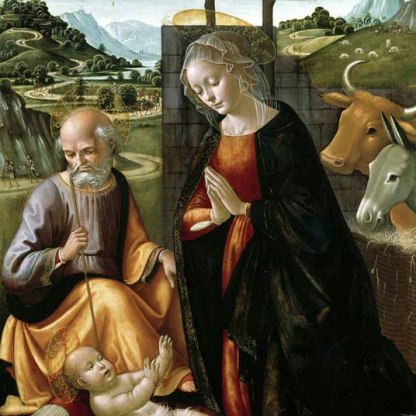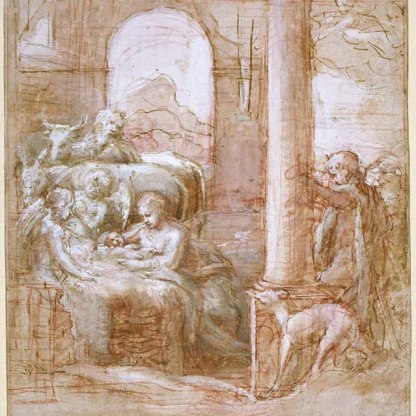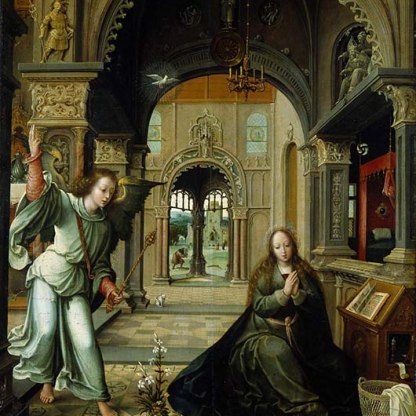The Nativity

This panel was once thought to have been painted by Sebastiano Mainardi, Domenico Ghirlandaio's brother-in-law. Mainardi is known to have worked for Ghirlandaio and paintings by the two artists have been confused before, a confusion that sheds light upon the workings of a Renaissance artist's workshop. Several versions of the same composition exist and it is likely that apprentices in Ghirlandaio's workshop made copies based upon his original design, copies to which the master himself may have put the finishing touches. The overall quality of the painting here, however, with its delicate brushwork and rich, fresh colours, suggests that we are looking at the work of Domenico's own hand.
The subject is the Adoration of Christ, an episode following the Nativity, in which Mary kneels over her new-born son in prayer. Joseph, who is much older than his wife, sits on the ground behind Christ, while an ox and an ass observe the miraculous baby from their stall, a crude shelter with a derelict roof.
In the background, behind the animals, an angel floats on a golden haze above a distant hillside, announcing the news of the Saviour's birth to the shepherds.
Behind Joseph's head, a long procession can be seen travelling along a winding road: it is the Magi from the East, following the star that shines high above them. At the left of the picture two poorly dressed men travel the same road, perhaps the shepherds again, who, having been told of the miraculous birth, are already on their way to pay their respects to the child.
The artist has included within the canvas several non-simultaneous events, suggesting in a single image all the important elements of the Nativity story.
Domenico, who himself may have learned to paint in the studio of Fra Filippo Lippi, was the master of one of the biggest, busiest and most successful botteghe – artists' workshops – in Florence at the end of the fifteenth century. He was an astute businessman who provided art for the rich merchant class in Florence at a time when the city, under Lorenzo de' Medici, was the most artistically sophisticated in Italy. When Domenico died in 1494, his brother Davide took over the running of the workshop. The Fitzwilliam owns a painting by Davide, The Virgin and Child Enthroned between St Ursula and St Catherine [M.2].
In the spring of 1487, Ghirlandaio's workshop admitted the twelve-year-old Michelangelo Buonarrotti as an apprentice. The document, stating the terms under which Michelangelo was employed in the bottega, still survives. It explains that:
...the said Michelangelo must stay for the stipulated time with the above named, to learn and practise the art of painting, and that he should obey their orders, and that the same Domenico and Davide should pay him in those three years 24 florins of full weight.
In later life Michelangelo would play down the influence of Domenico on his work, but it is to his first teacher's eternal credit that the 'divine' painter of the frescoes of the Sistine Chapel ceiling first learnt the technique in the Ghirlandaio workshop.
Themes and periods
Data from our collections database
He perhaps bought it from Messrs Colnaghi, London
Acquisition and important dates
- Method of acquisition: Bequeathed
- Dates: 1912
Maker(s)
Note
Formerly attributed to Mainardi, Sebastiano, reattrib. E. Fahy, 1998
Materials used in production
Read more about this recordStories, Contexts and Themes
Other highlight objects you might like
Suggested Curating Cambridge products
Sign up to our emails
Be the first to hear about our news, exhibitions, events and more…






